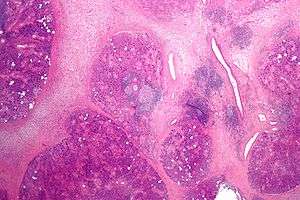Sialadenitis
| Sialadenitis(Sialoadenitis) | |
|---|---|
 | |
| Micrograph showing chronic sialadenitis. H&E stain. | |
| Classification and external resources | |
| ICD-10 | K11.2 |
| ICD-9-CM | 527.2 |
| MeSH | D012793 |
Sialadenitis (sialoadenitis) is inflammation of a salivary gland. It may be subdivided temporally into acute, chronic and recurrent forms.
Acute
- Predisposing factors
- sialolithiasis
- decreased flow (dehydration, post-operative, drugs)
- poor oral hygiene
- exacerbation of low grade chronic sialoadenitis
- Clinical features
- Painful swelling
- Reddened skin
- Edema of the cheek, Periorbital region and neck
- low grade fever
- malaise
- raised ESR, CRP, leucocytosis
- purulent exudate from duct punctum
Chronic
Main article: Chronic sclerosing sialadenitis
- Clinical Features
- unilateral
- mild pain / swelling
- common after meals
- duct orifice is reddened and flow decreases
- may or may not have visible/palpable stone.
- Parotid gland
- Recurrent painful swellings
- Submandibular gland
- Usually secondary to sialolithiasis or stricture
- Treatment
In chronic recurrent sialadenitis or chronic sclerosing sialadenitis, acute attacks are managed with conservative therapies such as hydration, analgesics (mainly NSAIDs), sialogogues to stimulate salivary secretion, and regular, gentle gland massage.[1] If infection is present, appropriate cultures should be obtained, followed by empirical antibiotic therapy initially,[1] for example amoxicillin/clavulanate or clindamycin which cover oral flora.
If there are attacks more than approximately 3 times per year or severe attacks, surgical excision of the affected gland should be considered.[1]
See also
References
- 1 2 3 bestpractice.bmj.com > Sialadenitis Last updated: Sep 08, 2011
This article is issued from Wikipedia - version of the 6/22/2016. The text is available under the Creative Commons Attribution/Share Alike but additional terms may apply for the media files.